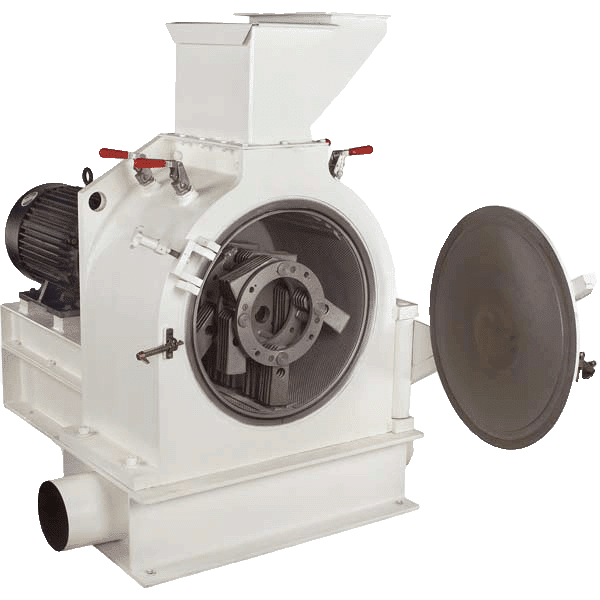Hammer Mills
Hammer mills reduce particle size of materials by crushing it between two colliding pieces of metal, thus the name. This method is extremely effective and can reach very high throughputs with very little footprint. However it is very rough and not desirable when trying to avoid creating fine particulates or generally trying to be gentle with product. They are commonly used in the processing of agricultural products, feed and grain, distilling, wood products, and minerals.
Hammer mills operate on the principle that most materials will shatter or break when subjected to a high-energy impact force. The material is fed into the mill and impacted by a series of hinged “hammers” as seen in the image. The material is then ground or pulverized by the hammers and forced through the grinding plate, which is selected according to the desired particle size.
Advantages
One of the main advantages of hammer mills is their versatility. They can be used to grind a wide range of materials, from grains and wood chips to rubber and plastics. They can also be used to process a variety of materials, including food, chemicals, and minerals.
Another advantage of hammer mills is their efficiency. They are able to process large quantities of material in a relatively short period of time, making them ideal for use in high-volume production environments. They are also relatively low maintenance, as they have few moving parts and are simple to operate.
Hammer Mill Disadvantages
One of the main drawbacks is that they generate a relatively large amount of noise and vibration, which can be a concern in some work environments. They also produce a large amount of dust, which can be a safety hazard unless paired with a dust collection system. Third, because they operate by forcing product through a mesh, exceptionally sticky product can clog the mesh and reduce efficiency. Finally, they generate more heat than other methods, which can be cause for concern in applications when compounds or the nutrients within are sensitive to heat.
When To Use A Hammer Mill
There are several factors to consider when selecting a hammer mill for a particular application. These include the type and size of the material being processed, the desired particle size, the capacity of the mill, and the available power source.
There are also several types of hammer mills available on the market, including horizontal hammer mills, vertical hammer mills, and fixed hammer mills. Horizontal hammer mills, like the Prater models shown above, have a horizontal orientation and are driven by an electric motor or diesel engine. They are typically used for small to medium-sized operations. Vertical hammer mills, like the Schenck model shown above, have a vertical orientation and are driven by a motor or belt. They are typically used for larger operations.
Hammer Mills as Compared to Roller and Pin Mills
As usual, selecting the right tool for the job involves a lot of moving parts and will depend on the specific requirements of the application, including the type and characteristics of the material being ground, the desired particle size, the capacity requirements, and the available power source.
- Material characteristics: Hammer mills are generally more suitable for harder, less maliable, and more abrasive, such as animal feed, grains, and minerals. Roller and pin mills are typically better suited for softer materials, such as plastics and certain types of food products.
- Particle size requirements: Hammer mills are typically better equipped to produce a wider range of particle sizes, as they can achieve both coarse and fine grinding. Roller and pin mills are typically used for finer grinding, and are not as effective at producing larger particle sizes.
- Capacity requirements: Hammer mills are generally more suitable for high-capacity operations, as they are able to process large quantities of material in a relatively short period of time. Roller and pin mills are typically better suited for smaller-scale operations, as they may not be able to handle the same volume of material as a hammer mill.
Preferred Suppliers
The available hammer mills on the market vary wildly in price and quality, so the unit we source will completely depend on your application. We have good relationships with many OEMs and can use our purchasing frequency to get you a better price than going direct.
